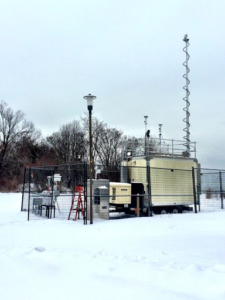The Field Measurement Facility is equipped with state-of-the-art instrumentation capable of characterizing aerosol according to size and composition. Research in this facility aims to study the spatial and temporal variation of aerosol properties, as well as identify sources of urban aerosol production. It is located in the University of Toronto’s Wallberg Building, and samples air directly from the north side of 200 College Street.
Ambient air is supplied to the instruments through a dedicated 10 cm diameter duct system, drawn at 2m/s by a blower that exhausts through the roof of the building. Each instrument samples a small fraction of this flow of outside air through a connection to the duct located immediately above the instrument. These ducts are well insulated to minimize any temperature changes during transport to the instrumentation and line losses are less than 10%.
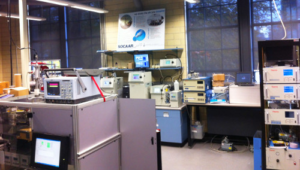
The Aerosols Chemistry Facility is located in the Lash Miller Building of the Department of Chemistry, within the Faculty of Arts and Science, University of Toronto. Research in this facility focuses on investigating atmospheric chemical processes occurring on or as a result of aerosol. The facility includes a number of reactions chambers and tubes that are used to simulate atmospheric chemistry conditions of interest.
BioTox is SOCAAR’s cell culture and biochemistry facility. The laboratory provides facilities to study the in vitro and in vivo effects of air pollution exposure in acellular, cell culture, and mouse animal models. The facility is equipped with a biosafety cabinet used for the safe cell culture of multiple airway cell lines. The laboratory also contains a Molecular Devices VermaMax Plate Reader, an Upright Fluorescent Microscope System with image acquisition and a Luminex 200 System. The facility is located in the Gage Research Institute Building, Room B14, at 223 College Street.
BioTox is also associated with Dr. Chung-Wai Chow’s Laboratory at the University Health Network’s Toronto Medical Discovery Towers. Dr. Chow’s lab is equipped to perform non-invasive measurement of cardiovascular and respiratory function in mouse models (i.e., tail cuff blood pressure measurements and plethysmography, respectively).
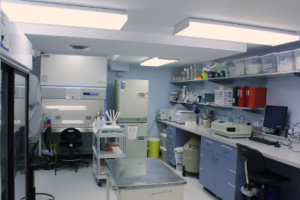
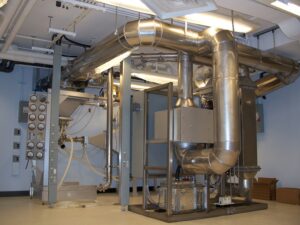
The Concentrated Ambient Particle Exposure Facility is used to study the health effects of ambient particulate matter on animals and humans. This facility is in the basement of the Gage Occupational and Environmental Health Unit, within the University of Toronto’s Faculty of Medicine. Research is conducted using three Concentrated Ambient Particle Systems (CAPS) developed and built by the Harvard School of Public Health. Each CAPS is responsible for isolating and concentrating ambient particulate matter in the coarse, fine, or ultrafine size ranges. The resulting concentrated particulate is used for inhalation studies under well controlled and characterized conditions. Research in this facility is investigating the pathophysiological mechanisms underlying the cardiovascular and respiratory effects of aerosol inhalation. Markers of autonomic dysfunction, systemic inflammation and endothelial activation are being examined through both in vivo and in vitro methodologies. The physiological responses of healthy individuals, and those from susceptible populations, are being investigated through controlled exposures
The following information provides a brief description of each CAPS found in the Concentrated Ambient Particle Exposure Facility:
-
High Volume Coarse Particle Concentrator (HVCPC)
The HVVPC is used to concentrate aerosol whose aerodynamic diameter ranges from 2.5 to 10 µm. The system is capable of increasing ambient coarse particle concentrations by a factor of 70 using a 5000 LPM single-stage conventional impactor with a 10 µm cutpoint, and a 500 LPM two-stage slit nozzle virtual impactor with a cutpoint of 2.5 µm. The system has minimal particle losses, and distortion of ambient coarse particle size distribution is negligible.
-
High Volume Fine Particle Concentrator (HVFPC)
The HVFPC is used to concentrate aerosol whose aerodynamic diameter ranges from 0.15 to 2.5 µm. The system is capable of increasing ambient fine particle concentrations by a factor of 30 using a high-volume conventional impactor with a 2.5 µm cutpoint, and three virtual impactors in series with cutpoints of 0.15 µm.
-
High Volume Ultrafine Particle Concentrator (HVUPC)
The HVUPC is capable of concentrating aerosol with an aerodynamic diameter less than 0.1 µm. The system can increase ambient ultrafine particle concentrations by a factor ranging from 40-50 using a size-selective inlet, a condensational growth unit, a series of two virtual impactors, and a thermal dilution-dryer section. An input ambient air flow of 5000 LPM enters a conventional impactor with a 2.5 µm cutpoint. The condensational growth unit saturates the ambient air with water vapor, and then sends the air through a cooling system, which supersaturates the water vapor. The supersaturated water condenses onto the particles in ambient air, which promotes their growth. The ambient air then enters a series of two virtual impactors with cutpoints of 1.0 µm. The thermal dilution-dryer section eliminates excess water from the particles, thereby allowing the aerosol droplets to return to their original size distribution. The concentrated ambient air, at a flow rate of 50 LPM, is diluted with 8 LPM of particle free air, and heated to 90°F. The 58 LPM of ambient air is sent to a size selective outlet with a cutpoint of 0.15 µm.
-
Human Inhalation-Toxicology Exposure Chamber (HITEC)
The concentrated particulate flows form any of the three concentrators flows into HITEC where the exposure of the volunteers occurs. The dimensions of the chamber are 76” x 72” x 40” (H x L x W), which allows an individual to exercise during exposure.
The chamber is constructed with stainless steel tubing and polycarbonate in order to ensure an unreactive and well-sealed system.
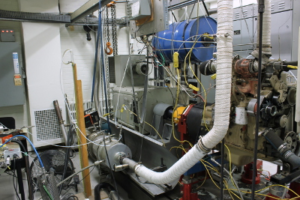
The Engine Combustion and Emissions Facility specializes in research on the combustion of alternative fuels, including biodiesel, bio-oil, and biogas, methanol, natural gas, propane and hydrogen in spark ignition and diesel engines. It is located in the Mechanical Engineering Building in room 120 (MC120). The focus of the work is on reducing engine exhaust emissions.
The SOCAAR portion of the Engine Combustion and Emissions Facility includes the following:
- TSI Model 3090 Engine Exhaust Particle Sizer
- MKS MultiGas 2030HS - Fourier Transform Infrared Spectrometer (for gas phase characterization)
- Dilution systems: Dekati FPS 4000 Fine Particle Sampler (ejector dilution system) and the TSI Rotating Disk Thermodiluter
- Dekati thermodenuder (removal of volatile phase)
- CAI Emissions Bench equipped with a variety of gas analyzers
- Clean room for filter weighing (temperature and humidity controlled to EPA standards
- DMT photoacoustic soot spectrometer
- Magee Scientific AE33 7-wavelength aethalometer
- a laser induced incandescence (LII) instrument seen here: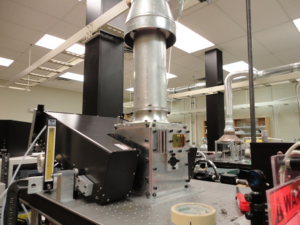
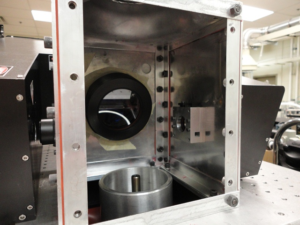

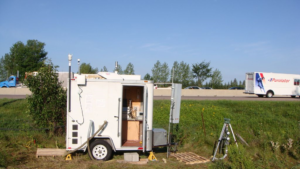
MAPLE (Mobile Analysis of ParticuLate in the Environment) is a mobile sampling vehicle capable of measuring the spatial and temporal variations of ambient aerosol characteristics. MAPLE’s mobile sampling platform is advantageous because it can provide a large pool of information about a designated geographical range, rather than stationary facilities, which only rely on a few locations. MAPLE can also be used to study atmospheric processes, map concentration distributions of aerosols, and determine the composition of emission sources and their influence on local and regional air quality. This being said, MAPLE can take a snapshot of a region’s atmospheric chemistry, so that aerosol production and dispersion in Southern Ontario can be better understood.
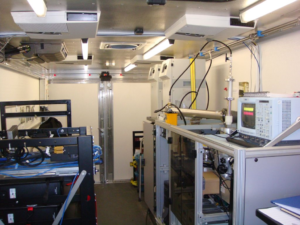
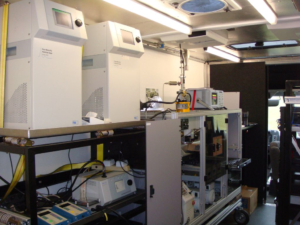
MAPLE (Mobile Analysis of ParticuLate in the Environment) is a mobile sampling vehicle capable of measuring the spatial and temporal variations of ambient aerosol characteristics. MAPLE’s mobile sampling platform is advantageous because it can provide a large pool of information about a designated geographical range, rather than stationary facilities, which only rely on a few locations. MAPLE can also be used to study atmospheric processes, map concentration distributions of aerosols, and determine the composition of emission sources and their influence on local and regional air quality. This being said, MAPLE can take a snapshot of a region’s atmospheric chemistry, so that aerosol production and dispersion in Southern Ontario can be better understood.
The rooftop measurement site is five stories high, and measures gaseous and particle-phase pollutant levels above the street canyon where coinciding measurements are made at the ground level. Filter-based integrated sampling is also conducted on a biweekly basis on the rooftop as part of Environment Canada’s National Air Pollutant Surveillance Program research-focused objectives.
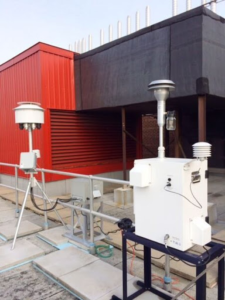
Containing many of the same instruments, the monitoring station deployed on Toronto Island is the background compliment to the on-campus SOCAAR facility. Measurements of gas and particle-phase pollutants, along with local meteorology, are conducted in real time and transmitted via cellular communication. These data serve as a baseline reference for downtown Toronto, and allow the contribution of local emissions to urban air quality to be more accurately assessed.
